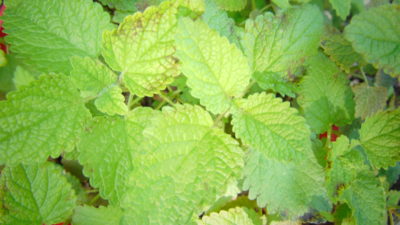5 Easiest Herbs to Grow!
I’ve always loved growing herbs. Often, I didn’t use them for anything other than to smell and admire on occasion. it wasn’t until I learned about the healing benefits of herbs that I really took a closer look at what I was growing. Over the years, I’ve learned that some herbs are high maintenance while others are happy when left alone to do their thing. And there ain’t no crime in wanting to get the most out of your herbs with the least amount of effort!
And thankfully, there are many herbs out there that require very little attention or maintenance.
Allow me to introduce you to the joy of growing herbs!
One of the things I love about herbs is that many of them are self-sufficient. Meaning, they’re some of the easiest herbs to grow. Some can even grow in nothing more than a glass of water. How much easier do you need!
Below are my most favorite, low-maintenance herbs. These plants don’t ask for much but offer a lot in return . If you don’t have space for an in-ground garden, these herbs will do well in pots on the patio or on the kitchen window sill. As you’ll see below, herbs are versatile enough to be used in everything from cooking to the home apothecary.
Basil
A couple years ago, I had gotten a late start on planting Basil when I planted my tomatoes. When it came time to make some homemade tomato-basil soup, I had no fresh Basil because my plants weren’t mature enough to harvest. By chance, my local supermarket had fresh plants in the produce section. Now, you can easily grow Basil from seed but my tomatoes were ready NOW!
Two plants were more than enough for my soup canning event. So I decided to experiment. I placed one plant in potting soil while the other one lived in a glass of water on the window sill. The water was changed every couple of days. Both of them lived on the window sill until they got too big. They eventually joined my other plants in the garden.
Basil is an annual which means it’s only good for one growing season. You can practice succession planting if you want Basil year round. If you use as much Basil as I do, you’ll want to stagger your planting so they don’t become mature all at the same time. That’s assuming that you weren’t like me and forgot to plant them when you should have!
If you take cuttings from Basil regularly, it will get bushy. As I mentioned previously, a window sill will only hold them for a short time before they need more room. Basil prefers direct sun. If it has a growth spurt and you want to continue to keep it inside, you’ll need to re-pot to keep it from becoming root-bound.
Why you need it: Pesto, dressings/marinades, herb butter, flavored cooking oil, tinctures and tea. Also deters hornworms from eating your tomato and pepper plants.
Mint
This is one of those plants that should be in a container as it’s the foremost authority on hostile takeovers! Once you plant it in the ground, it’s hard to get rid of! It doesn’t mind indirect light, can also survive in nothing but water and only needs occasional fertilizer.
Why you need it: Both peppermint and spearmint leaves can be used in cooking, teas, hydrosols, potpourri and lotions. In the garden, it can keep critters out due to its strong aroma.
Oregano
Did you know that Greek and Italian Oregano are pretty much the same thing? How about the fact that Marjoram is a type of Oregano? Or that Mexican Oregano isn’t really Oregano at all but is part of the Verbena family? The things you learn! All this to say that no matter what type you have, Oregano is a perennial and one of the easiest herbs to grow. They prefer sun and should be allowed to dry out between watering: clay pots are best for this. If they live outside most of the year they’ll need to be brought in during cold weather. Take occasional clippings and like Basil, it will get bushy over time.
Why you need it: Pasta sauce, homemade seasoning blends, tinctures and teas. Oregano also provides food for beneficial insects like Lacewings. Lacewings eat all the bad insects like aphids and whiteflies. Also like mint, certain critters don’t like the smell of Oregano and will avoid any area where it’s planted.
Thyme
This is another perennial herb that’s best in a clay pot. Like Oregano, water thoroughly and let it dry out before watering again. Fertilize every couple of weeks and trim the old, woody growth to keep it producing. And make sure you’re growing “culinary” Thyme and not the ornamental variety.
You will need to re-pot it if you see the roots coming through the bottom of the pot. It will do well on a window sill with indirect light.
Why you need it: Soups, stews and homemade seasoning blends. In the garden, it attracts pollinators and is deer resistant.
Lemon Balm
You can grow Lemon Balm from seed but it’s better and faster to purchase a plant. It will grow in just about any kind of soil and doesn’t need fertilizer. In fact, fertilizer may change the strength of its scent.
Lemon Balm a member of the mint family and will do well once established. You can park it on a window sill with indirect light or for a few hours in full sun on the patio. Keep it close just so you can run your hand over it and smell it’s lemony fragrance!
Why you need it: Tea, cooking, potpourri and insect repellent. Lemon Balm is also another aromatic plant that keeps critters away from your veggies.
See…told you it would be easy!
Seriously, growing herbs is not that hard. Follow the advice mentioned above and don’t forget to use houseplant fertilizer at half-strength when needed.
Plants kept on a window sill will need to be rotated so the plants can get even amounts of light on all sides. Plants will automatically lean toward the light. If you see this happening, you’ll know it’s time to rotate the pots.
If you don’t want to grow your own herbs and you have a farmers market nearby, you can usually find these and many other herbs available for sale.
As I mentioned earlier, you may also find a small selection of herbs in your grocery store’s produce department. Use them up right away, preserve them by drying or take a stab at keeping them alive for awhile.
Either way, you still get the full benefits of the herbs themselves. That’s a win-win in my book. Maybe you’ll see for yourself that these really are the easiest herbs to grow, no matter what color your thumb!
Until next time,
lisa
LisasSimpleLife is a participant in the Amazon Services LLC Associates Program, an affiliate advertising program designed to provide a means for sites to earn advertising fees by advertising and linking to Amazon.com.
Subscribe
If you like what you see, click on the subscribe button so you don’t miss anything!
I promise not to spam you! By clicking the subscribe button, you agree to my privacy policy.









